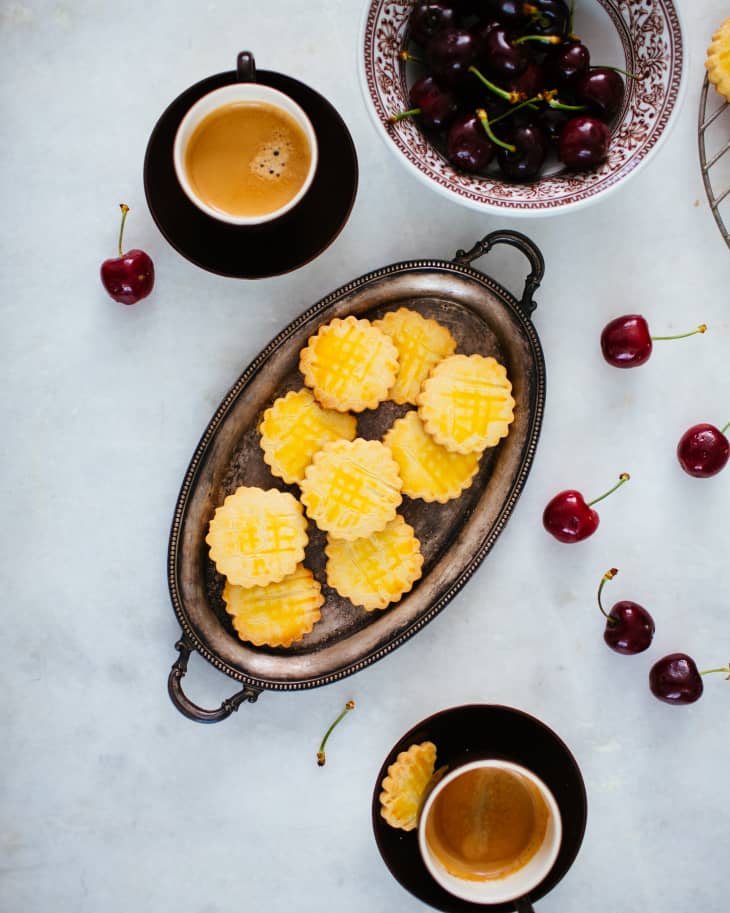Recipe: Galette des Brittany (Salted Butter Cookies)

Makesabout 36 (2-inch) cookies
Au revoir, Paris! Ann Mah takes us off the tourist path on a culinary tour of France’s favorite regional foods.
Hailing from the region of Brittany, which is located on the far edge of northwestern France, these shortbread cookies may appear ordinary, but don’t be fooled by their plain-Jane appearance. These Breton biscuits are special because they rely on cultured butter to flavor them … and that’s it. No vanilla, no citrus zest — just high-quality, salted butter.
Brittany is famous for a few things: its wild, rugged coastline, its unique Celtic culture, its unpredictable climate, and — perhaps most of all — its crêpes, both sweet and savory. The latter, which are also called galettes (just to confuse things!), are made of buckwheat, which was first planted by Duchess Anne of Bretagne in the 15th century, who recognized it as one of the few plants that could thrive in the region’s poor soil. Although buckwheat galettes are now commonly stuffed with savory ingredients like ham and cheese, they were traditionally eaten plain, fried in butter, and dabbed with even more butter at the table.
This, then, is the region’s other staple food — beurre de baratte, churned butter made from fermented cream and flecked with grains of flaky salt, which preserved the product in the days before refrigeration. (Salt was untaxed and thus used with abandon.) In fact, butter is so important in Brittany that the town of Quimper – largely acknowledged as the French capital of crêpes – has a central market square called Place au Beurre.
Salted, cultured butter has a soft texture and delicate flavor reminiscent of toasted hazelnuts. It appears in many Breton sweets, from caramels to kouign-amann (a kind-of caramelized forerunner to the cronut) to galettes bretonnes. Originally a traditional recipe from granny’s kitchen, Pont-Aven biscuit factories started making them around the turn of the 20th century — and as Brittany’s tourist industry grew, people brought them home and made them popular throughout France.
As galettes bretonnes rely on butter to flavor them, you want use the best you can find. Happily, cultured butter is more widely available outside of France, found at well-stocked supermarkets or high-end cheese shops — look for brands like Vermont Creamery, Graziers, Organic Valley, Sierra Nevada, Isigny Sainte-Mére, or Banner Butter. You can, of course, use regular butter, too, but don’t forget the sea salt; the combination of sweet, salty, and buttery is irresistible.
Galette des Brittany (Salted Butter Cookies)
Makes about 36 (2-inch) cookies
Nutritional Info
Ingredients
- 14 tablespoons
(7 ounces) salted butter, softened at room temperature for 1 hour
- 2 teaspoons
flaky sea salt, such as fleur de sel
- 1 cup
powdered sugar
- 3
large egg yolks
- 3 cups
all-purpose flour
- 1
large egg yolk
- 1 teaspoon
water
Instructions
Place the butter and salt in the bowl of a stand mixer fitted with the paddle attachment. (Alternatively, use an electric hand mixer and a large bowl.) Beat on medium speed until smooth, about 30 seconds. Add the sugar and egg yolks and beat for several seconds until light and fluffy.
With the mixer on low speed, gradually add the flour and beat until fully incorporated. Do not overwork the dough.
Gather the dough into a flat disk and wrap it in plastic wrap. Refrigerate for at least 1 hour or up to 5 days.
Arrange a rack in the middle of the oven and heat to 320ºF. Line 2 baking sheets with parchment paper; set aside.
Place the dough between 2 sheets of parchment paper. Using a roll pin, roll it out until about 1/4 inch thick. Remove the top sheet of paper. Using a 2-inch round fluted cookie cutter, cut out as many rounds as you can. Place them on the lined baking sheet about 1/2 inch apart. Gather the scraps and re-roll the dough to make additional cookies until both sheets are filled, about 18 per baking sheet.
Beat the egg yolk with the water in a small bowl. Brush the top of each cookie with the egg yolk mixture. Using the back of a fork, press a cross-hatch pattern into the top of each cookie.
Bake the cookies 1 sheet at a time until the edges turn pale gold, 10 to 12 minutes. (Refrigerate the second baking sheet while the first is baking.) Remove the cookies from the oven and allow to cool completely on the baking sheet on a wire rack.
Recipe Notes
Storage: The cookies can be stored in an airtight container at room temperature for up to 3 days.
A Culinary Tour de France!
Join Kitchn and celebrated food writer Ann Mah as we take a tour of France’s tastiest regions. On this trip, we’re skipping Ile-de-France, home of the city of light, and celebrating the foods and flavors of Occitania, Côte d’Azur, Normandy, Brittany, and Alsace. We’ll cook our way through an iconic dish from each region and explore how they’ve helped France earn its status as one of the gastronomic hubs of the world.
